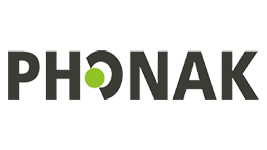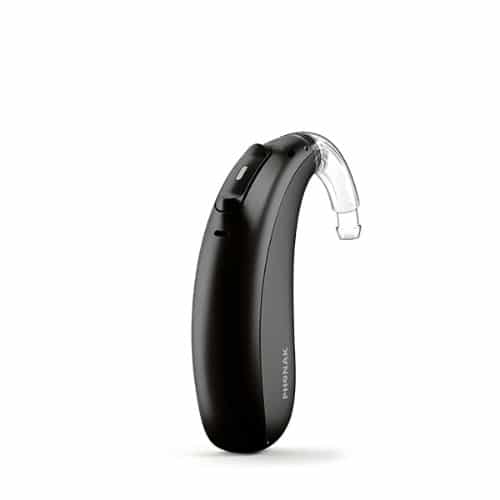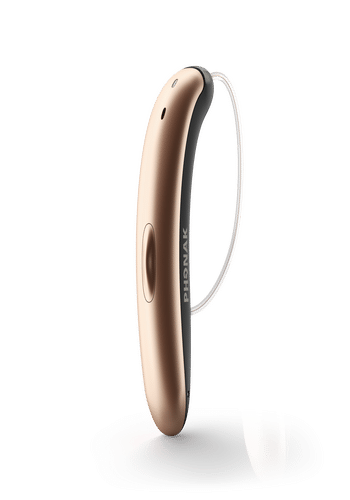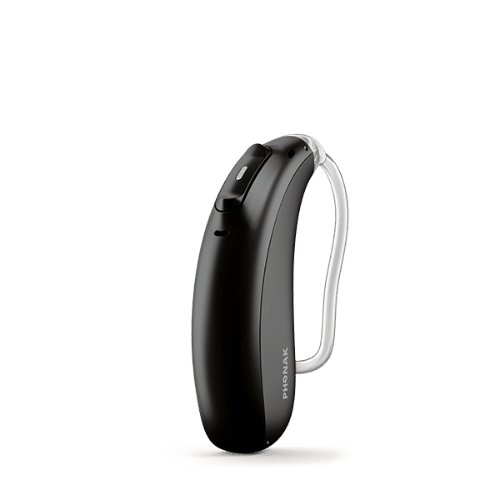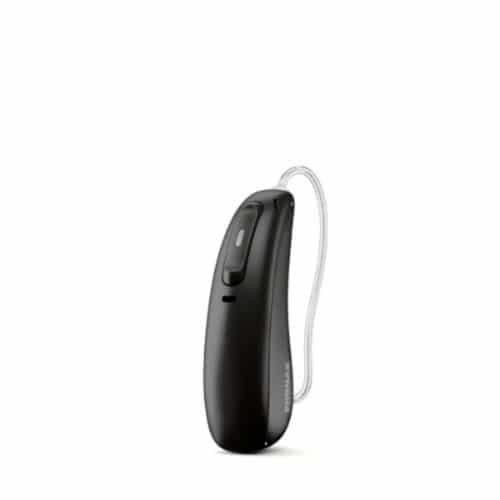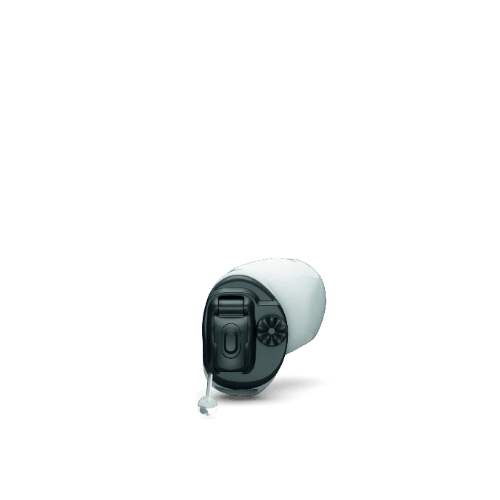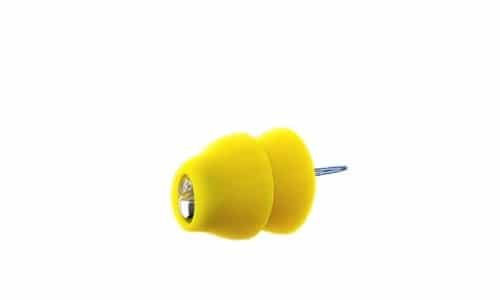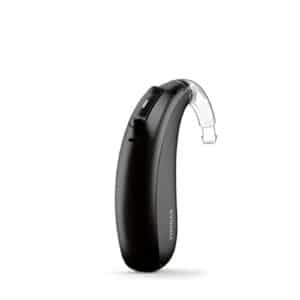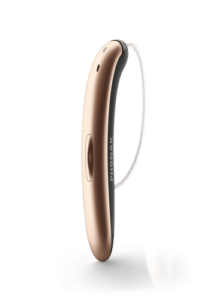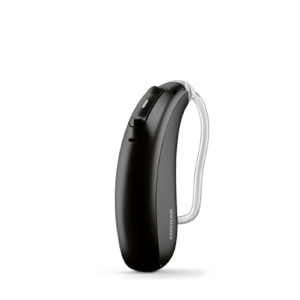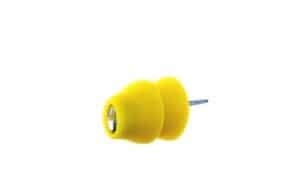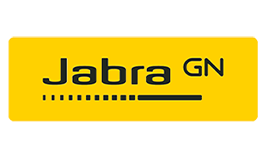In addition to being waterproof and available in eight color options, this model has high-tech features like AutoSense for sound environment adjustment, Roger wireless technology, a TV Connector feature, and Bluetooth connectivity wit streaming capabilities.
Phonak Hearing Aids Review 2025: Tried and Tested by Us
Phonak Hearing Aids Review: Key Takeaways
- The costs vary depending on the model and range from $2,100–$7,000 per pair.
- To purchase Phonak hearing aids, you must consult with an audiologist or hearing specialist.
- The company offers four different styles of hearing aids: behind-the-ear (BTE), receiver-in-canal (RIC), in-the-ear (ITE), and invisible-in-canal (IIC).
- We recommend Phonak thanks to the brand’s great audiology support, ability to treat mild to profound hearing loss, useful smartphone app, and advanced hearing technology features like AutoSense and ActiveVent Receiver.
With so many hearing aid companies to choose from, each with different models and various levels of advanced technology, it can be challenging to decide which hearing aid works best for you and your hearing loss. To help you make sense of it all, our team researched Phonak, one of the largest hearing aid companies on the market, and created this Phonak hearing aids review.
This review dives into the pros and cons of Phonak hearing aids, details each of Phonak’s hearing aid models, compares Phonak versus other brands, and summarizes Phonak hearing aids customer reviews. We hope this helps you or your loved ones search for the best hearing aids.
Why trust our expert review?
Our team recommends products and services we believe provide value in the lives of our readers. We’ve spent more than 5,000 hours conducting in-depth research on hearing aid devices to give you the most accurate hearing aid review. To make these selections, we:
- Consulted with audiologists and geriatric care experts
- Mystery shopped 18 brands
- Surveyed hundreds of hearing aid users
- Tested various models of hearing aids
- Interviewed experts in the field
- Read thousands of verified customer reviews
Read more about our hearing aid review methodology.
Phonak hearing aids: pros and cons
Comparison of Phonak hearing aids models, as of 2025
|
Bolero Marvel
Visit Site
|
Slim
Visit Site
|
Naída Paradise
Visit Site
|
Audéo™ Lumity
Visit Site
|
Audéo Paradise
Visit Site
|
Virto Paradise
Visit Site
|
Lyric
Visit Site
|
|
|---|---|---|---|---|---|---|---|
| Starting cost per pair | $2,100 | $2,400 | $1,359–$6,000 | $2,010–$4,800 | $2,450 | $2,450 | $3,000–$6,000 |
| Type of hearing aid | BTE | BTE | BTE | RIC | RIC | ITE | IIC |
| Type of hearing loss | Mild to moderate | Mild to profound | Severe to profound | Mild to profound | Mild to profound | Mild to severe | Mild to severe |
| Battery type | Traditional | Rechargeable | Rechargeable or traditional | Rechargeable | Rechargeable or traditional | Traditional | Single-use, non-rechargeable |
| Bluetooth | Yes | Yes | Yes | Yes | Yes | Yes | No |
| Water resistant | Yes | Yes | Yes | Yes | Depending on version | Yes | Yes |
| Telecoil | Yes | Yes | Depending on version | Depending on version | Depending on version | N/A | N/A |
| Directional microphone | Yes | Yes | Yes | Yes | Yes | Yes | N/A |
| Noise reduction | Yes | Yes | Yes | Yes | Yes | Yes | N/A |
| Processing channels | Yes | Yes | Yes | Yes | Yes | Yes | Yes |
Phonak hearing aids review: popular models
History of Phonak
Established in Zurich, Switzerland, in 1947, Phonak has 123 international subsidiaries and distributors around the world. In 2006, Phonak launched its Hear the World initiative to raise awareness about hearing loss worldwide, including the social and psychological effects of hearing loss and options for prevention and treatment. Since then, Phonak has launched water-resistant hearing aids, as well as models to help manage tinnitus and single-sided hearing loss.
Purchasing Phonak hearing aids
You might be wondering how and where to purchase Phonak hearing aids, how much they cost, if insurance covers them, and how you can save money. In this section, we break down those questions.
How and where do I purchase Phonak hearing aids?
To purchase Phonak hearing aids, you need to work with an audiologist or licensed hearing instrument specialist. Some brands, such as Eargo and Jabra Enhance, offer hearing aids without an in-person consultation and provide free online hearing tests. But Phonak hearing aids cannot be bought online—you must purchase them directly from an authorized retailer such as an audiologist clinic.
If you want professional support and don’t mind an in-person consultation, visit the Phonak website to search for Phonak preferred providers in your area. You can also find an audiologist via the American Academy of Audiology.
Phonak hearing aids cost and insurance
Phonak hearing aids vary in price, starting from $2,100–$4,260 per pair, depending on the model. But prices can climb to more than $7,000 per pair based on hearing aid customizations. Ask if your hearing professional or audiologist offers a discount, financing, or payment plans. Also, reach out to your insurance provider to learn what is covered because some private health plans may cover the cost.
According to our team’s survey of hearing aid users, more than 28% of Phonak users reported that the hearing aids are expensive, compared to only 9% of Audicus users, 23% of Jabra Enhance users, and 25% of Signia users.
Cost of hearing aids with disposable vs. rechargeable batteries
Like most hearing aids, Phonak hearing aids with rechargeable batteries generally cost more than Phonak hearing aids with disposable batteries. For example, the Phonak Bolero Marvel with disposable batteries starts at $2,100 per pair, while the Phonak Naída Paradise with rechargeable batteries starts at $2,400, with the main difference between the models being battery type.
While disposable batteries last only a few days before needing to be replaced, rechargeable batteries are designed to last the hearing aid’s life, which is about five years. If a rechargeable battery dies while the hearing aid is still under warranty, you should be able to get it replaced at no cost. If it dies after the warranty has expired, it’s usually best to buy a new hearing aid, as rechargeable batteries are quite expensive.
Phonak warranty
Many hearing aid companies offer three-year warranties, but Phonak only provides a one-year international warranty, beginning the day you purchase your hearing aids. An additional two years of repair, loss, and damage coverage is available for an extra fee at the time of purchase.
The warranty covers:
- Manufacturer or material problems
The warranty does not cover:
- Batteries
- Tubes
- Ear modules
- External receivers
Local warranties vary, so check with your audiologist or hearing professional.
Phonak online hearing test
Phonak offers an online hearing test to help you determine if you have hearing loss. But, it’s important to note that online hearing tests can’t diagnose the cause of your hearing loss, just the presence of hearing loss. More research on online or app-based hearing tests is needed to determine whether they’re a good replacement for in-person hearing tests.
For example, a study published in the Journal of the American Geriatrics Society, which focused on age-related hearing loss (ARHL), stated that “given their low cost and relative accessibility, smartphone-based hearing apps may facilitate screening for ARHL,” but “further research and validation efforts are necessary to determine whether smartphone-based hearing assessments are a feasible and accurate screening tool for ARHL.” [1]Irace, Alexandria L., et al. Smartphone-Based Applications to Detect Hearing Loss: A Review of Current Technology. Journal of the American Geriatrics Society. Dec. 19, 2020. Found on the internet at https://agsjournals.onlinelibrary.wiley.com/doi/10.1111/jgs.16985
“Online hearing tests can be a good way to determine if you should take the next step of having an in-depth diagnostic evaluation,” said Sarah Lundstrom, Au.D, an audiologist with Hearing Care in Venice, Florida. But “they do not check for other causes of hearing loss, such as wax impaction, ear infections, or other medically treatable causes of hearing loss.”
Hearing professionals recommend you see an audiologist for an in-person hearing test before purchasing hearing aids online.
Phonak app and accessories
Phonak offers four different smartphone apps: myPhonak app, myPhonak Junior app, myRogerMic app, and myRogerCoach app.
- myPhonak app: Compatible with Phonak Bluetooth-enabled hearing aids, this app allows for telehealth ⓘTelehealth is the use of technology platforms to deliver health and health-related services, so you can receive health care remotely. services, custom programs, and a hearing aid remote control, allowing you to adjust volume and frequencies on Phonak hearing aids.
- myPhonak Junior app: Compatible with Phonak Bluetooth-enabled hearing aids, this app is designed for children and allows remote support with your child’s audiologist.
- myRogerMic app: Through the app, you can control the Roger On microphone, while the person speaking holds the microphone in their hand, clips to their clothing, or sets on a table. You can mute, unmute, and change microphone modes.
- myRogerCoach app: This app guides you on how to use your Roger On or Roger Select microphones.
Phonak offers seven wireless accessories: Roger On, Roger Clip-On, Roger Table Mic II, Roger Select, Phonak PartnerMic, TV Connector, and Phonak RemoteControl.
- Roger On: When background noise is present, this microphone allows hearing aid users to focus on one person talking.
- Roger Clip-On: This small clip-on microphone helps make one-on-one conversations easier by automatically adjusting to noise levels and speakers around you.
- Roger Table Mic II: Designed for people who participate in frequent meetings or conference calls, this microphone is dedicated to helping you hear all participants.
- Roger Select: Like the Roger Table Mic II, the Roger Select is a microphone that lets users focus on a specific conversation when multiple conversations are happening in the same room.
- Phonak PartnerMic: This microphone helps during one-on-one conversations in noisy environments and provides a directional listening experience without having the person face you directly.
- TV Connector: This accessory allows you to stream TV and music directly to your Bluetooth-enabled hearing aids.
- Phonak RemoteControl: Coming in a discreet design, this remote control has three buttons—one for program changes and two for turning your hearing aid volume up or down.
Customizing Phonak hearing aids
You can customize your hearing aid settings through the myPhonak app, with different accessories, on your hearing aids, or with support from your hearing care professional. The options are explained here.
- myPhonak App: The myPhonak app has buttons that you slide to adjust volume, frequencies (such as treble and bass), noise reduction, and more. You can also select programs for different listening situations. The app is compatible with Naída Paradise, Bolero Marvel, and Audéo Paradise.
- Accessories: Phonak has a few accessories for you to make your own hearing aid volume adjustments and program settings, such as the Phonak RemoteControl or Phonak PilotOne II. The plus (+) button increases the volume, and the minus (-) button decreases it. The third button changes your program settings.
- Hearing aids: Depending on the model, you can control the volume by pressing upward on the multifunctional button to increase the volume and downwards to decrease it. If you have reduced dexterity or vision, you may prefer to use the app to adjust your hearing aid volume, as the multifunctional button can be small and hard to manipulate.
Customer service and satisfaction
Phonak customer support is available through:
- Phone (1-800-679-4871)
- Email (info@phonak.com)
- Online form (https://www.phonak.com/en-us/contact)
Our team spoke to Phonak customer service several times and received conflicting answers on model dimensions and weight. For specific Phonak hearing aid questions, the company recommends working with your local hearing care provider.
Phonak also has several watch-and-learn videos that cover:
- Connecting to iPhone or Android phones
- Phonak hearing aid accessories
- myPhonak smartphone app
- Hearing aid maintenance
In our survey of hearing aid users, more than 70% of Phonak hearing aid users reported it was easy or extremely easy to clean their hearing aids. More than 75% said it was extremely easy to change or charge Phonak hearing aid batteries. The survey also indicated that more than 9% of Phonak users are extremely dissatisfied with the comfort and fit of their hearing aids, compared to 5% of Starkey hearing aid users.
Phonak vs. other brands comparison, as of 2025
| Cost per pair | $2,600-$6,500 | $799–$1,995 | $299–$699.98 |
| Type of Hearing Aids | Behind-the-ear | Receiver-in-canal | Behind-the-ear, receiver-in-canal, completely-in-canal |
| Type of hearing loss | Mild to profound | Mild to moderate | Mild to severe |
Phonak hearing aid customer reviews
In our survey of hearing aid users, more than 28% of Phonak respondents reported that their hearing aids didn’t have enough features, but only 4% stated their hearing aids didn’t look appealing. Customer reviews for Phonak vary among different sites, including the Better Business Bureau (BBB) and Trustpilot. On BBB, Phonak has an A+ rating but a customer review rating of 2.11 out of 5, based on nine reviews. On Trustpilot, Phonak has a “poor” rating, with 1.8 out of 5 stars, with 34 reviews. Reviews are as of September 2023.
“I have used Phonak for years for assistive tech devices for students. We have not been disappointed in the products or service.”
STARLA, VERIFIED CUSTOMER REVIEW (BBB.ORG)
“Love my hearing aids much better than my old pair and [they are] very small, no one can tell I am wearing them.”
DEREK, VERIFIED CUSTOMER (TRUSTPILOT.COM)
“I purchased a Phonak Audeo P90 RT hearing aid in October and it failed at the end of August. I sent it back to Phonak at the beginning of September. Phonak has been working on it for five weeks. The company says they do not have the parts to fix it. I only have hearing in one ear and the loss in that ear is very bad. I would have gone with my second choice [of hearing aids].”
PATRICIA, VERIFIED CUSTOMER REVIEW (BBB.ORG)
Phonak Hearing Aids: Bottom line
Phonak is a reputable brand that makes quality hearing aids. For the last 70 years, Phonak has been supporting people with hearing loss. Phonak hearing aids are for people with mild to profound hearing loss, are built with advanced technology, and come in various styles.
Phonak hearing aids may be the right choice for you if:
- You’re looking for special features and advanced technology
- You want a reputable hearing aid company with various hearing aid styles
Phonak hearing aids may NOT be the right choice for you if:
- You want the ease and convenience of buying a hearing aid online
- You want or need less expensive hearing aids, are not covered by insurance (Medicare C, FSA, HSA, Veteran, etc.), and are not eligible for support through Lions Clubs, charitable foundations, or your local area agency on aging
Frequently asked questions
Yes. Phonak has been around for more than 70 years and makes technologically advanced hearing aids. Depending on your needs, you can find a hearing aid model with telecoils, noise reduction, or water-resistance, and you have options for either rechargeable or traditional batteries.
Hearing aids last anywhere from three to seven years, depending on how they’re worn, cared for, stored, and how much moisture and heat they are exposed to. The battery life of Phonak’s lithium-ion rechargeable hearing aids is 24 hours after a single charge.
Sonova makes Phonak hearing aids and operates four other brands as well, providing hearing devices, audiologist care, consumer hearing, and cochlear implants.
Phonak manufacturing facilities are located in Switzerland, China, and Vietnam. More than 100 countries around the world distribute Phonak hearing aids.
Phonak is unique because it’s one of the industry’s longest-run hearing aid companies. For more than 70 years, the company has produced hearing aids to help manage tinnitus and single-sided hearing loss, and has helped lead the hearing industry in technological advancements, including special features like Bluetooth connectivity and voice-to-text transcription of phone calls.
Have questions about this review? Email us at reviewsteam@ncoa.org.
Sources
- Irace, Alexandria L., et al. Smartphone-Based Applications to Detect Hearing Loss: A Review of Current Technology. Journal of the American Geriatrics Society. Dec. 19, 2020. Found on the internet at https://agsjournals.onlinelibrary.wiley.com/doi/10.1111/jgs.16985

